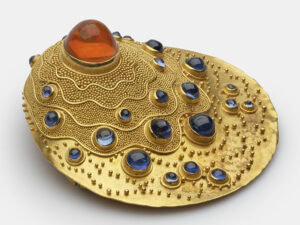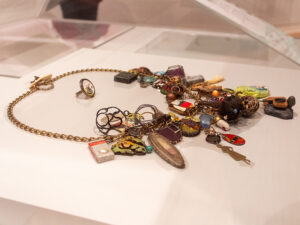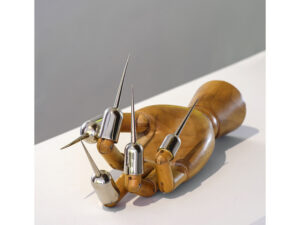
It is to this thrill of the glorious and to Berger’s keen eye for evocative jewelry that the Museum of Arts and Design pays homage by showcasing some 450 pieces from the 4500 objects of adornment that Berger has amassed for more than half a century. Berger’s serendipitous ties to her father’s diamond fortune and her second husband’s work in diamond mining are played down by positioning the collector as a meritocratic visionary and by highlighting her audacious and visionary approach to curating her personal wardrobe. In the exhibition’s accompanying book, published by Assouline, fellow jewelry enthusiast Iris Apfel writes an endearing reflection on her relationship with Berger and touts the collection on display as, “a veritable visual history of the art and craft of costume jewelry.”
The historical and personally transformative nature of the exhibition is what comes through most successfully. The visitor’s journey into the collection begins by positing the material improvisations of adornment in ancient Egypt as an origin of costume jewelry practice. Specifically, for want of more valuable alternatives, Egyptians employed “humble” materials such as glass and raw metals to imitate the precious and refined materials of the elite. The exhibition builds on this practice and fleshes it out into something more existential, more impactful and empowering.
The pieces suggest that, as they rise to the specific challenge of creating glitter out of glass, select designs of costume or “fashion” jewelry prove to match, if not surpass, the innovation and wonderment of “real” jewelry. Quite apart from their historical value as put forth in the exhibition, it is difficult to resist the temptation of mentally gauging the impact of those exuberant and luminous pieces on one’s body, as Berger insists that, “a woman’s power is revealed through her jewelry.”
MAD chief curator David Revere McFadden invited Barbara Berger to assist Dorothy Globus in curating a collection. The exhibition at MAD is the first in the United States that truly elevates and displays Berger’s pieces in a catalogued and reverent manner.
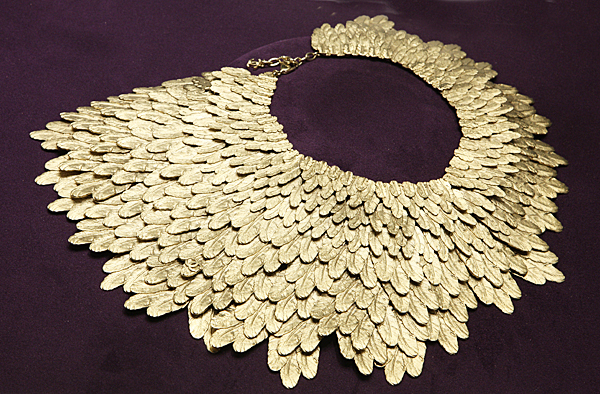
The curator’s emphasis on Berger’s wide-ranging acquisitions remains consistent with the overall culture and objective of the museum under its chief curator McFadden. Firstly, the exhibition upholds the value of innovative and painstaking design. While costume jewelry is rarely subjected to the same level of scrutiny as contemporary or luxury jewelry, Berger’s collection bears witness to costume jewelry’s undaunted expressive potential, and it debunks the idea that it is a less inventive form of artistic expression. Secondly, and perhaps more importantly, it tracks the progressive history of the democratization of design that empowers the wearer. This comes through most significantly in the first cases of post World War II jewelry with historical images of women wearing “frankly fake” pearls and stones to remain participants in fashionable adornment. Iris Apfel suggests as much, when she writes that Barbara Berger has harvested a material culture and visual history that educates visitors on the service that costume jewelry has contributed over time in making beautiful design accessible.

Berger’s more outlandish acquisitions are situated toward the back of the exhibit, perhaps owing to the sexual subject matter of some of the designs. Here, we become familiarized with the more eccentric approaches to costume jewelry design in the past 70 years. Billy Boy and Daniel von Weinberger—whose neon, spaghetti-like neck ornament is featured on the cover of the exhibition catalogue—are displayed within steps of quirky pieces from 1930s jewelry innovator Line Vautrin.
Curator Globus managed the preponderance of jewelry with a floral motif (primarily featuring American designers) by displaying them in various cases within the larger exhibition space, along with the diamonds and rhinestones that were on limited view until September 22, 2013. Highlights of the exhibition offered a sense of Barbara Berger’s whimsical and gutsy fashion sense. These included a pearl, glass, and metal encrusted face mask designed for Berger to wear to a masquerade ball in Venice, as well as the uniquely masterful handcraft by Berger’s contemporary favorite, Iradj Moini.
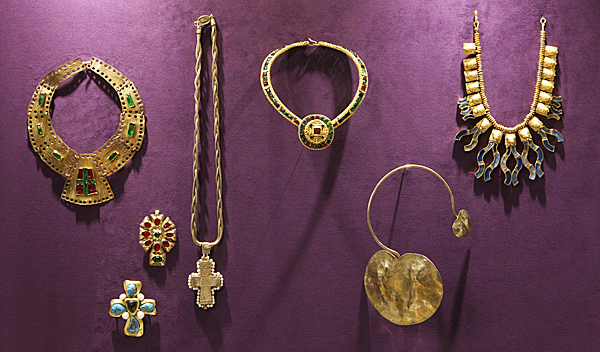
Overall, the exhibition met my expectations of opulence and fantasy—a presumption guided by the widely circulated advertisements featuring a Maison Gripoix feather bib necklace or an Iradj Moini Austrian stone-encrusted lobster brooch—while offering an eye-pleasing walk through jewelry history. As visitors meander about the exhibition, the configuration of the space blurs the line between fine art and commerce. The presentation of wearable objects hovering behind the glass, just within reach, is like a retail window display.
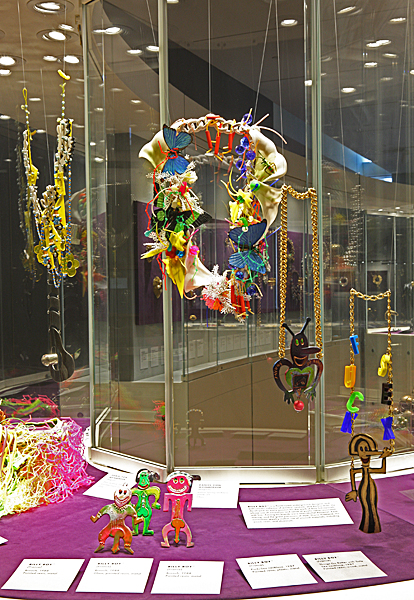
One thing made the exhibition slightly inaccessible. There are many pieces on display, and the viewer must carefully follow the object labels to understand which label corresponds to which object. Because clusters of jewelry are displayed in various cases, it may have been clearer to attribute the object to its designer with a small number discreetly placed next to or under the object and an accompanying label panel listing the numbered objects. Similarly, the audio tour may be slightly confusing to follow. The Museum of Arts and Design did a fine job of posting smartphone-friendly audio descriptions, but the placement of some of the objects tagged with audio labels were not so easy to locate.
Upon reflection, Fashion Jewelry: The Collection of Barbara Berger reveals itself to be an exhibition for our time, illuminating how the sharing of one’s individuality has become increasingly commonplace, as we, in one way or another, organize and display our own tastes, ideas, and personal style through social media. The narrative of how Barbara Berger has found solace throughout her life and navigated the bounds of her creativity can be found in this exhibition. It is not only her story. It could quite possibly be ours as well. Over the summer, the museum produced programming that coincided with the exhibition, encouraging us to investigate how jewelry and adornment can be emblematic of our identity. Berger becomes introspective about her collection, understanding that it is more profound than a vanity project. She welcomes us into her world of self-expression, prefacing the exhibition’s book with a passionate revelation about the way in which the cultivation of our personal style and our engagement with valuable objects tempers how we navigate adversity: “After many years of searching for my mother, I realize that I have found her through the discovery of her style, and I have triumphed over stressful times through the fantasy and the baroque with the soft touch of the magical wand that is my jewelry collection.”



